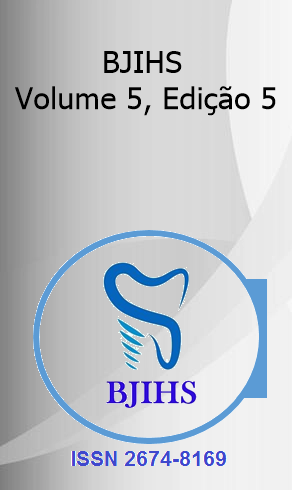Abstract
Objective: Clear aligners are an alternative to conventional orthodontic appliances, and are increasingly indicated due to their discreet aesthetics and comfort for patients. The search for an aesthetic appearance plays a significant role in the demand for restorative dental treatments. The aim is to find out the real benefits of clear aligners compared to conventional orthodontic appliances in the context of aesthetic restorative treatment. Issues related to stability of results, treatment time, patient comfort and positive psychological impact are addressed. Methodology: the present study is a narrative literature review that used the following databases: Pubmed (NIH), SciELO, Medline and Google Scholar, and searched for articles published between the years 2013 to 2023 and after following the inclusion and exclusion criteria, 18 articles were considered eligible. Results: Aesthetic restorative treatment involves improving the appearance of teeth, whether through tooth whitening, direct or indirect restorations, porcelain veneers, among other procedures. Clear aligners can play an important role in this process, allowing for a less invasive and more conservative approach. However, on the other hand, there are conventional braces, which, despite being unaesthetic, can play roles that aesthetic braces cannot. Conclusion: Although transparent aligners have many advantages, especially in terms of comfort and aesthetics, the movements generated for the treatment of more serious defects are still limited compared to conventional orthodontic appliances.
References
ALMEIDA, J. R. et al. Resin-based luting agents and color stability of bonded ceramic veneers. The Journal of prosthetic dentistry, v. 114, n. 2, p. 272–7, 2015.
ALMOGBEL, A. Clear Aligner Therapy: Up to date review article. Journal of orthodontic science, v. 12, n. 1, p. 37–37, 1 jan. 2023.
BLANCO, P. C. et al. Restauração de dentes conóides com resina indireta: relato de caso. UNOPAR Cient., Ciênc. biol. saude, 2015.
CARDOSO, L. G. et al. A Era da Evolução na Ortodontia: Sistema Invisalign® / The Age of Evolution in Orthodontics: Invisalign® System. ID on line REVISTA DE PSICOLOGIA, v. 13, n. 45, p. 489–499, 30 maio 2019.
COELHO, B. S.; MELO, W. J. DE; KERVAHAL, P. A. Benefícios e limitações do aparelho ortodôntico transparente: uma revisão narrativa. Scire Salutis, v. 12, n. 1, p. 369–375, 2022.
DANIELE, V. et al. Color Stability, Chemico-Physical and Optical Features of the Most Common PETG and PU Based Orthodontic Aligners for Clear Aligner Therapy. Polymers, v. 14, n. 1, p. 14, 21 dez. 2021.
D’APUZZO, F. et al. Clear aligner treatment: different perspectives between orthodontists and general dentists. Progress in Orthodontics, v. 20, n. 1, 11 mar. 2019.
ERCOLI, F. et al. A comparative study of two different clear aligner systems. Progress in Orthodontics, v. 15, n. 1, 2 maio 2014.
FALTIN, R. M. et al. Eficiência, planejamento e previsão tridimensisonal de tratamento ortodôntico com sistema Invisalign«; relato de caso. Rev. Clín. Ortod. Dent. Press, p. 61–71, 2003.
GALLUCCIO, G. Is the use of clear aligners a real critical change in oral health prevention and treatment? La Clinica Terapeutica, v. 172, n. 2, p. 113–115, 15 mar. 2021.
GERMINIANI, W. I. S.; TERADA, H. H. Avaliação da preferência estética de cirurgiões-dentistas (Clínicos gerais e ortodontistas), acadêmicos de Odontologia e leigos quanto às medidas indicadas por proporções conhecidas como padrão estético para o sorriso. Rev. dental press estét, p. 85–99, 2006.
GRABER, T. M.; VANARSDALL, R. L.; VIG, K. W. L. Orthodontics: current principles & techniques. St. Louis: Elsevier Mosby, 2017.
GÜREL, G. Predictable, precise, and repeatable tooth preparation for porcelain laminate veneers. Practical procedures & aesthetic dentistry: PPAD, v. 15, n. 1, p. 17–24; quiz 26, 2003.
HENNESSY, J.; AL-AWADHI, E. A. Clear Aligners Generations and Orthodontic Tooth Movement. Journal of Orthodontics, v. 43, n. 1, p. 68–76, mar. 2016.
LOMBARDO, L. et al. Class II subdivision correction with clear aligners using intermaxilary elastics. Progress in Orthodontics, v. 19, n. 1, 1 set. 2018.
MACHADO, R. I. et al. Finalizações Estéticas Após Tratamento Ortodôntico – Relatos De Caso. Revista Saúde Multidisciplinar, v. 3, n. 1, 2015.
PRASAD, S. et al. 3D printing in dentistry. Journal of 3D Printing in Medicine, v. 2, n. 3, p. 89–91, jul. 2018.
ROSSINI, G. et al. Efficacy of clear aligners in controlling orthodontic tooth movement: a systematic review. The Angle orthodontist, v. 85, n. 5, p. 881–9, 2015.
SOBRAL, M. C. Solutions for atypical problems in the incisors area: a transdisciplinary challenge. Dental Press Journal of Orthodontics, v. 25, n. 2, p. 86–102, mar. 2020.
SOUZA, M. S. et al. Laminados cerâmicos – um relato de caso. Revista Pró-UniverSUS, v. 7, n. 3, p. 43–46, 16 dez. 2016.
SMALLWOOD, T. W. Invisalign and Porcelain: The Contemporary Restorative Powerhouse. Alpha Omegan, v. 102, n. 4, p. 148–151, dez. 2009.
TARTAGLIA, G. M. et al. Direct 3D Printing of Clear Orthodontic Aligners: Current State and Future Possibilities. Materials, v. 14, n. 7, p. 1799, 5 abr. 2021.
THOMAS, P. A; KRISHNAMOORTHI, D et al. Digital smile design. Journal of Pharmacy And Bioallied Sciences, v. 14, n. 5, p. 43, 2022.
WEINSTEIN, T.; MARANO, G.; AULAKH, R. Five-to-five clear aligner therapy: predictable orthodontic movement for general dentist to achieve minimally invasive dentistry. BMC Oral Health, v. 21, n. 1, dez. 2021.
ZHENG, M. et al. Efficiency, effectiveness and treatment stability of clear aligners: A systematic review and meta-analysis. Orthodontics & Craniofacial Research, v. 20, n. 3, p. 127–133, 26 maio 2017.

This work is licensed under a Creative Commons Attribution 4.0 International License.
Copyright (c) 2023 Nayane Rodrigues Gervásio, Millena Luiza Vaz da Silveira, Tatiana Carvalho Montes

